Steaks 101: Choosing the Best Cut for Your Grill
Steaks are a classic choice for grilling, but choosing the right cut can make all the difference in flavor and tenderness. There are several factors to consider when selecting a steak cut for your grill. The flavor of a steak is determined by factors such as marbling and aging, which contribute to its tenderness. The tenderness of a steak depends on the muscle it comes from and the amount of connective tissue it contains. Fat content also plays a role in flavor and tenderness, as well as cooking method, as different cuts of steak respond better to certain cooking techniques.
Understanding the characteristics of different steak cuts is essential in making the best choice. The ribeye, for example, is known for its rich flavor and tenderness due to its marbling. The New York Strip offers a balance of tenderness and flavor, while the filet mignon is exceptionally tender but may have a milder flavor. The T-bone steak provides both the strip and tenderloin muscles, giving you the best of both worlds. The sirloin is a versatile cut with a good balance of flavor and tenderness. The porterhouse is similar to the T-bone but has a larger filet portion. The flank steak is lean and flavorful but requires proper marinating and slicing techniques for optimal tenderness.

To choose the best steak cut for your grill, consider your preferences in flavor, tenderness, and fat content, as well as the cooking method you plan to use. knowing the proper techniques for cooking steaks on the grill, such as seasoning, preheating, and monitoring internal temperature, can ensure a delicious and perfectly cooked steak every time. By understanding these factors and following expert tips, you can confidently choose the best steak cut for your grill and create a memorable dining experience.
Key Takeaways:
- Flavor, tenderness, fat content, and cooking method are important factors to consider when choosing a steak cut.
- Popular cuts of steaks include Ribeye, New York Strip, Filet Mignon, T-Bone, Sirloin, Porterhouse, and Flank, each with their own characteristics.
- Choosing the best steak cut for your grill requires considering the desired flavor, tenderness, and fat content, as well as the cooking method you prefer.
Factors to Consider When Choosing a Steak Cut
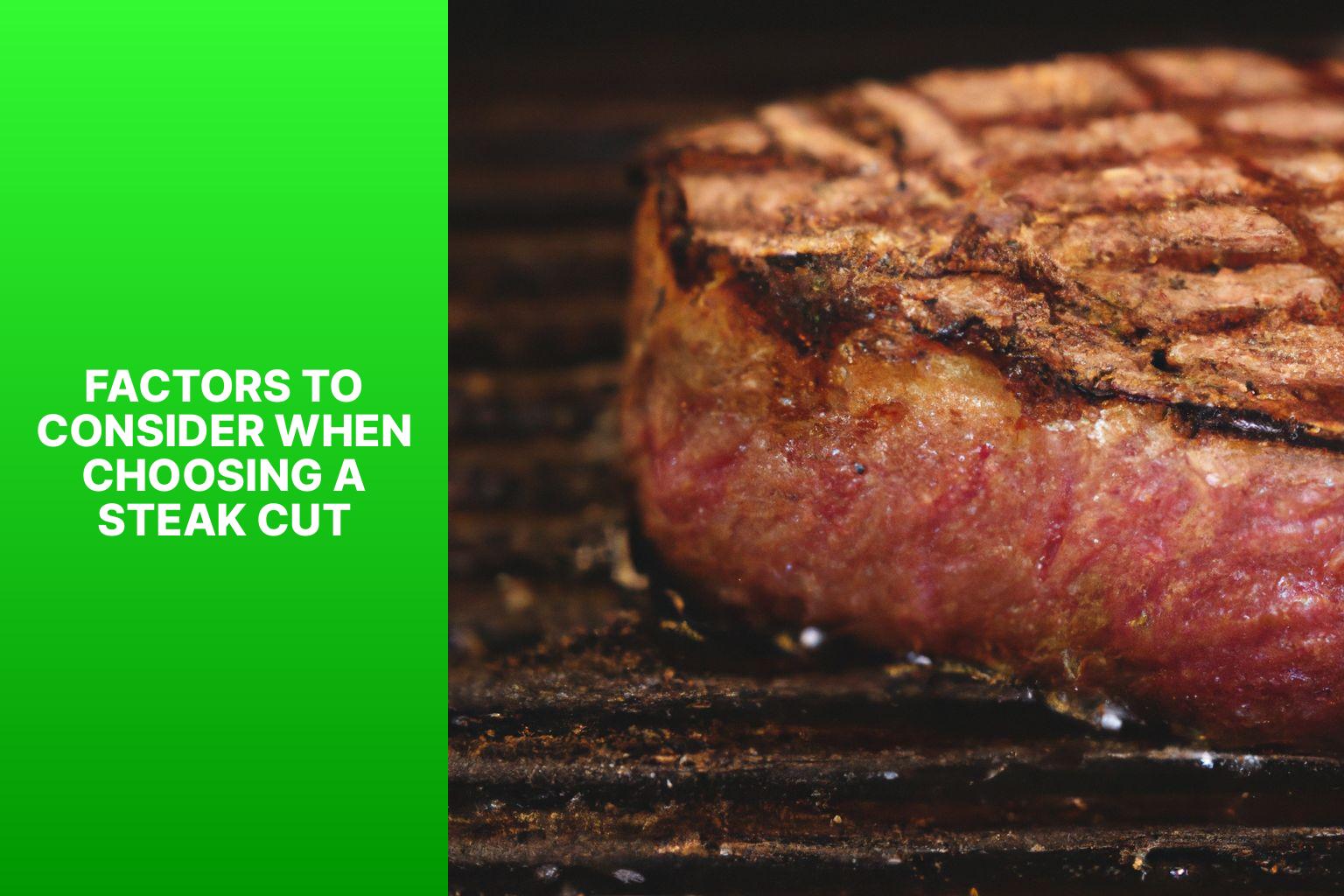
Photo Credits: Www.Moderngentlemanmagazine.Com by Zachary Green
When it comes to choosing the perfect steak cut for grilling, there are several factors to keep in mind. From the flavor profiles and tenderness to the fat content and preferred cooking method, each aspect plays a crucial role in making that mouthwatering steak experience. So, let’s dive into the juicy details and explore what makes each steak cut unique and how it can enhance your grilling game. Get ready to savor the flavors and unlock the secrets behind steak perfection!
Flavor
When it comes to choosing a steak, flavor is of utmost importance. It plays a significant role in shaping your overall dining experience. Here are some key aspects to keep in mind:
1. Cut of the steak: Different cuts offer different flavor profiles. Take, for instance, the ribeye, which is known for its rich and juicy nature, boasting a robust flavor. On the other hand, the filet mignon is renowned for its tenderness and subtle taste.
2. Marbling: The fat content, particularly the marbling, contributes greatly to the flavor profile. Greater marbling results in a more pronounced and savory taste.
3. Grass-fed vs. grain-fed: The diet of the cattle has a profound impact on the flavor. Grass-fed beef tends to exhibit a natural and earthy taste, while grain-fed beef has a sweeter and buttery essence.
4. Dry-aging: This particular process enhances the flavors, improves tenderness, and gives rise to a complex taste.
Consider these factors when selecting your steak to ensure it perfectly aligns with your taste preferences and desired dining experience.
Tenderness
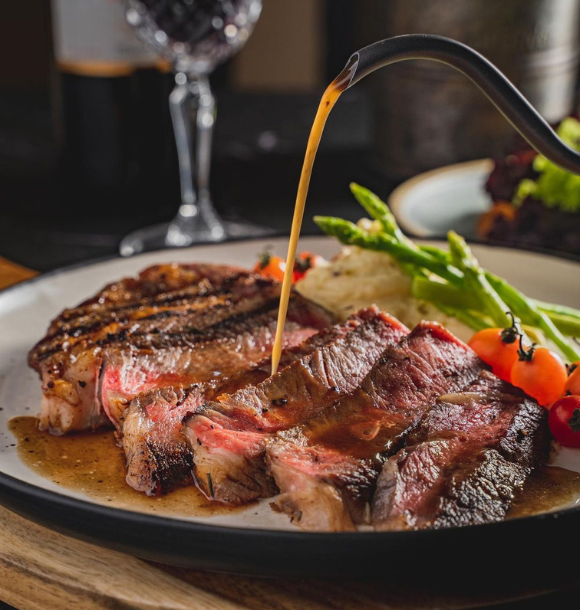
Photo Credits @marieltpadilla
When choosing the best steak, consider tenderness. Here are some key points to understand:
1. Tenderness measures how easy it is to chew and enjoy the steak.
2. Different cuts vary in tenderness due to muscle composition and location.
3. Steaks from less worked muscle areas are more tender, while those from well-exercised muscles can be tougher.
4. Prime cuts like filet mignon and ribeye are exceptionally tender.
5. Cuts like flank steak or skirt steak, although flavorful, are less tender due to more connective tissue.
6. Marinating the steak can enhance tenderness by breaking down muscle fibers.
7. Tenderizing techniques like pounding or using a meat tenderizer can also contribute to improved tenderness.
When selecting a steak cut, consider your preference for tenderness and the cooking method. For a melt-in-your-mouth experience, opt for tender cuts like filet mignon. If you prefer a slightly chewier texture, cuts like ribeye or New York strip offer a good balance between tenderness and flavor.
By understanding tenderness and exploring different cuts, you can choose a steak that caters to your taste preferences and cooking style. So, whether you’re hosting a barbecue or preparing a special meal, the tenderness of the steak will significantly impact your culinary experience.
Fat Content
The fat content of a steak is a crucial factor to consider when selecting the ideal cut for your grill. Fat significantly affects the steak’s flavor, tenderness, and juiciness. Here is a breakdown of the fat content for various steak cuts:
1. Ribeye: Ribeye steaks are known for their well-marbled fat, which contributes to their richness and flavor. The fat content in ribeye steaks ranges from 10% to 20%. Higher fat levels enhance tenderness and juiciness.
2. New York Strip: Compared to ribeye steaks, New York strip steaks are leaner. They typically contain around 5% to 10% fat. These cuts are a good choice for individuals seeking leaner options with less fat.
3. Filet Mignon: Filet mignon is renowned as the most tender cut with relatively lower fat content compared to other cuts. The fat content in filet mignon is typically around 5% to 8%.
4. T-Bone: T-Bone steaks consist of a T-shaped bone separating the tenderloin and strip steak. The tenderloin has a lower fat content, around 5% to 8%, while the strip steak has slightly higher fat content, ranging from 5% to 10%.
5. Sirloin: Sirloin steaks feature moderate fat marbling, typically around 8% to 12%. They offer a good balance between tenderness and flavor.
6. Porterhouse: Porterhouse steaks are similar to T-Bone steaks but come with a larger tenderloin portion. The fat content in porterhouse steaks is similar to T-Bone steaks, with lower fat content in the tenderloin and slightly higher fat content in the strip steak portion.
7. Flank: Flank steaks are lean cuts with minimal fat marbling. Their fat content usually ranges from 3% to 5%. Flank steaks are best enjoyed when cooked to medium-rare or medium to retain their tenderness.
When choosing a steak cut, it is essential to consider your preference for fat content. If you prefer a richer and more flavorful steak, opt for cuts with higher fat content, such as ribeye. Alternatively, if you desire a healthier option, choose leaner cuts like New York strip or filet mignon.
Cooking Method
The cooking method plays a crucial role in determining the taste and texture of steaks. When considering how to cook your steak, it’s important to keep these steps in mind:
– Grilling: To achieve a smoky flavor and a charred exterior, cook the steak directly over high heat. Make sure to preheat the grill, place the steak on the grates, and flip it halfway through the cooking process.
– Searing: If you want to create a delicious brown crust on your steak, cook it on high heat. Heat a skillet or grill pan, add oil, place the steak in the pan, and cook it on each side until a crust forms.
– Broiling: Another option is to cook the steak under a high-heat broiler in the oven. It’s important to preheat the broiler, place the steak on a broiler pan, and cook it on each side, flipping it halfway through.
– Pan-frying: If you prefer to cook your steak on the stovetop, pan-frying is a great method. Heat oil or butter in a skillet, add the steak, and cook it on each side until you reach your desired level of doneness.
The choice of cooking method depends on personal preferences, desired level of doneness, and the equipment you have available. It’s always a good idea to experiment with different methods to find the one that suits your taste and cooking skills. Remember to let the steak rest before slicing it. This allows the juices to redistribute and ultimately enhances the flavor of the steak.
Cuts of Steaks and Their Characteristics
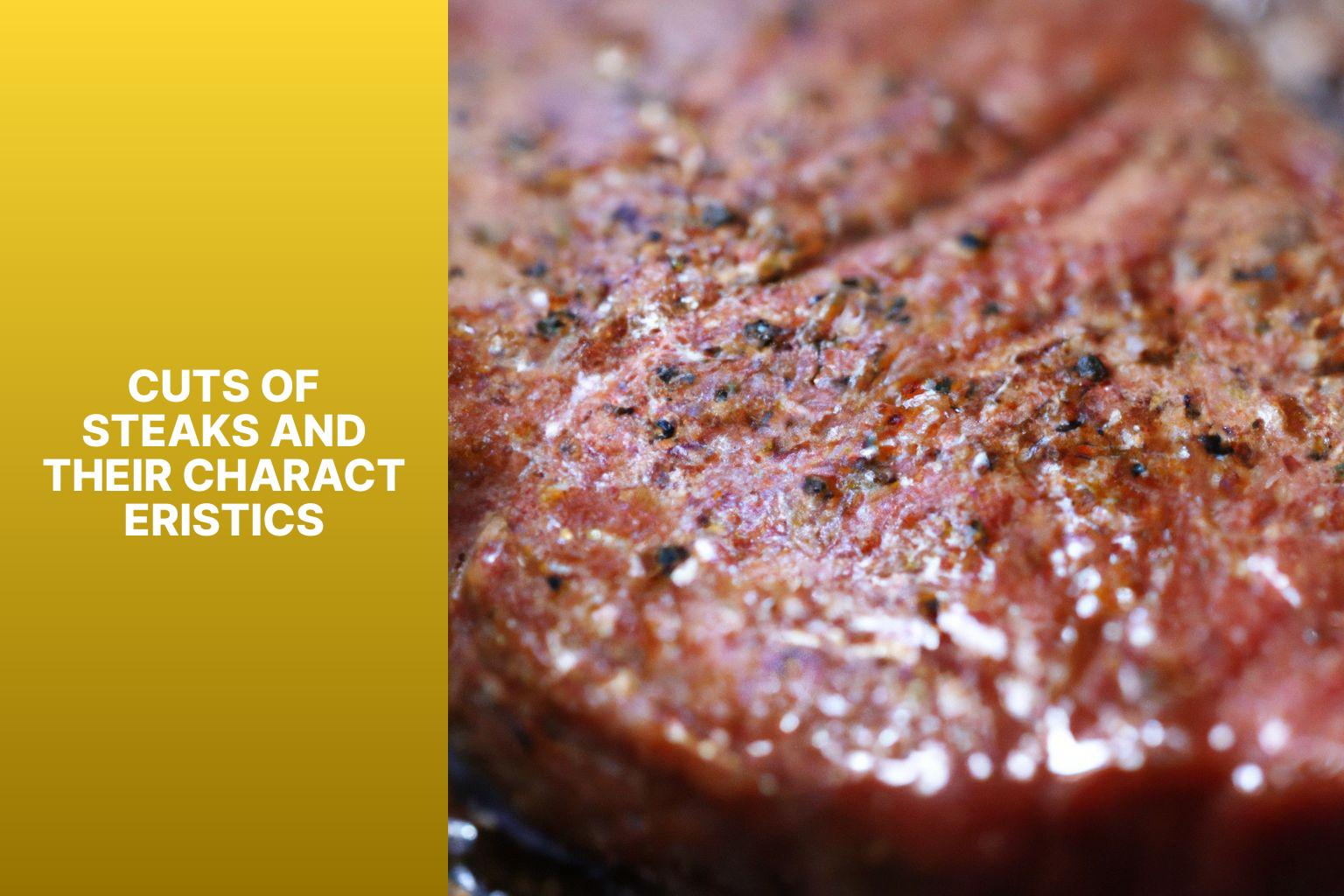
Photo Credits: Www.Moderngentlemanmagazine.Com by Matthew Williams
When it comes to steaks, understanding the different cuts and their characteristics is crucial. Get ready to tantalize your taste buds as we explore the world of ribeye, New York strip, filet mignon, T-bone, sirloin, porterhouse, and flank steaks. From the tender and marbled to the lean and flavorful, each sub-section will take us on a delicious journey, showcasing the unique qualities and mouthwatering experiences that these cuts have to offer. So grab your aprons and let’s dive into the sizzling realm of steaks!
Ribeye
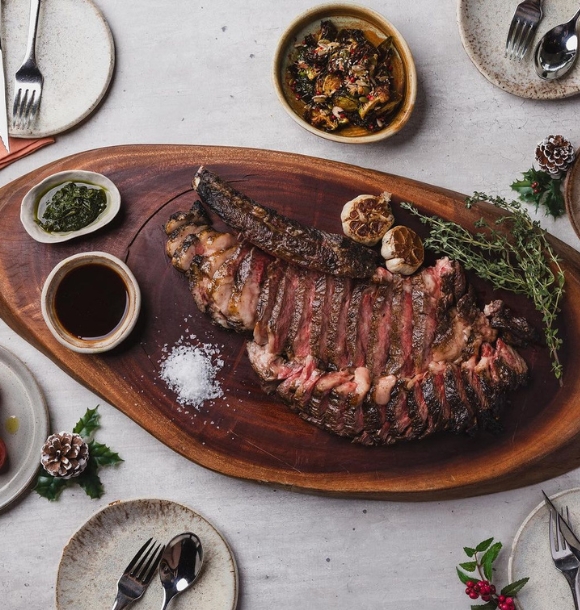
Photo Credits @fatbellysg
The ribeye steak is popular among grill enthusiasts for its exceptional flavor and tenderness. This meat comes from the beef rib section and is known for its rich marbling, which enhances its taste and juiciness when cooked. Here is a breakdown of the characteristics of ribeye steak:
- Flavor: The ribeye steak offers a delicious and robust beefy flavor. The marbling in the meat adds a buttery and melt-in-your-mouth texture, enhancing the overall taste experience.
- Tenderness: The ribeye is a highly tender cut of beef, making it a favorite among steak lovers. The fat marbling throughout the meat helps keep it moist and tender, resulting in a satisfying, juicy bite.
- Fat Content: The ribeye steak is well-marbled with fat, which contributes to its exceptional flavor and tenderness. The fat melts during cooking, infusing the meat with flavor and keeping it moist throughout the grilling process.
- Cooking Method: Ribeye steaks are best cooked using dry heat methods, such as grilling or pan-searing. The high heat helps sear the exterior and lock in the juices, resulting in a flavorful and caramelized crust.
When selecting a ribeye steak for grilling, choose one with ample marbling for the best flavor and tenderness. Aim for a thickness of around 1 inch for even cooking and a juicy interior. Season the steak with salt and pepper and let it come to room temperature before grilling to ensure even cooking. Cook the ribeye to your desired level of doneness, whether rare, medium-rare, or well-done. Let the steak rest for a few minutes after cooking to allow the juices to redistribute, then slice and serve for a delicious meal.
New York Strip
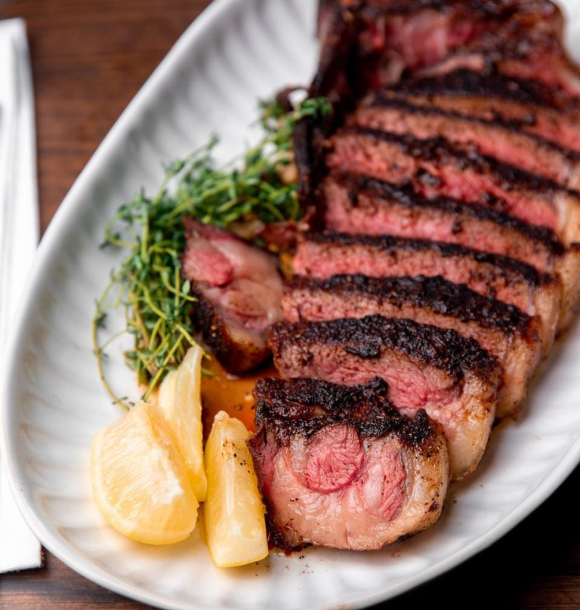
Photo Credits @alligatorpearnyc
The New York Strip is a popular steak known for its tenderness and rich flavor. It is a top loin steak cut from the short loin of the cow. Here are the characteristics of the
– Cut: Well-marbled, tender, and flavorful
– Flavor: Rich and beefy
– Tenderness: Tender and juicy
– Fat Content: Moderately marbled
– Cooking Method: Best suited for grilling or broiling
The New York Strip is prized for its tenderness and flavor. It has the right amount of marbling, which enhances its tenderness and taste. When cooked properly, it is juicy and bursting with beefy flavors. Its moderate fat content contributes to its succulence.
To prepare the New York Strip on the grill:
1. Preheat the grill to medium-high heat.
2. Season the steak with salt and pepper or preferred seasoning blend.
3. Place the steak on the hot grill and cook for about 4-5 minutes per side for medium-rare doneness.
4. Use a meat thermometer to check the internal temperature, which should be around 130-135°F for medium-rare.
5. Once cooked, let the steak rest for a few minutes before serving to allow the juices to redistribute, resulting in a moist and flavorful steak.
When choosing a steak cut for your grill, consider your preferences and cooking style. The New York Strip is an excellent choice for those who enjoy a balance of tenderness and bold beef flavors.
Filet Mignon
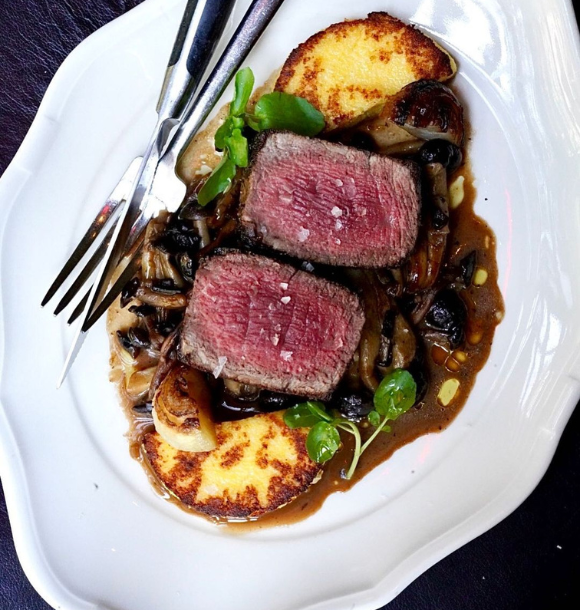
Photo Credits @laurenttourondel
A prized cut of steak known as filet mignon, is recognized for its exceptional tenderness and buttery texture. This luxurious and highly sought-after meat offers a melt-in-your-mouth experience.
When choosing filet mignon, it is important to consider factors such as size, grade, cooking method, and seasoning. Typically, this steak is cut into thick portions, ranging from 6 to 8 ounces, to ensure even cooking and moisture retention. For the best quality, opt for a higher grade of beef, such as USDA Prime or USDA Choice, which is made from the tenderloin.
To enhance the natural flavor and texture of filet mignon, it is recommended to use dry-heat methods such as grilling or pan-searing. This will result in a mouthwatering steak cooked to your desired level of doneness – rare, medium-rare, or medium.
For a simple and delightful taste, season filet mignon with just salt and pepper to bring out the natural flavors. Alternatively, you can add herbs and spices to further enhance the overall taste sensation.
T-Bone
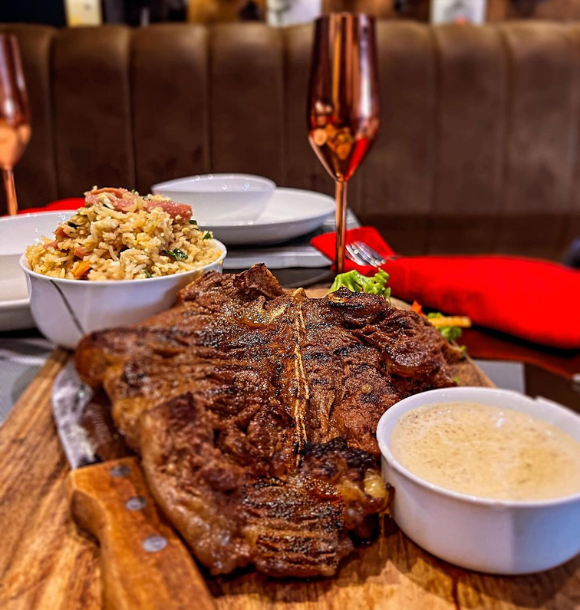
Photo Credits @crossoverrestaurant
The T-Bone steak combines the tenderloin and strip loin muscles in one cut. Here is a table comparing the characteristics of the T-Bone steak:
| Characteristics | T-Bone Steak |
| Flavor | The T-Bone steak has a rich, beefy flavor due to the combination of the tenderloin and strip loin. |
| Tenderness | The tenderloin side of the T-Bone is more tender compared to the strip loin side. Both sides offer good tenderness. |
| Fat Content | The T-Bone steak has moderate marbling, which adds to its flavor and juiciness. |
| Cooking Method | The T-Bone steak is versatile and can be grilled, broiled, or pan-seared. |
When choosing a T-Bone steak, look for fresh, bright red meat and well-marbled fat for the best flavor and tenderness. Also consider the thickness of the steak, as it affects cooking time. Thicker cuts require longer cooking to reach the desired doneness. Let the steak rest for a few minutes after cooking to allow the juices to redistribute and ensure a juicy, flavorful bite.
The T-Bone steak is a classic choice that offers the best of both the tenderloin and strip loin. Enjoy the rich flavor and tenderness of this delicious cut on your grill!
Sirloin
The sirloin is a popular steak cut that offers a balance of flavor and tenderness. It is located in the rear portion of the beef, near the loin, and is divided into two sections: the top sirloin and the bottom sirloin.
Here is a table highlighting the characteristics of the sirloin:
| Cut | Characteristics |
| Top Sirloin | Lean and tender with a rich, beefy flavor. It has a fine texture and is often more affordable than other premium steak cuts. Perfect for grilling, broiling, or pan-searing. |
| Bottom Sirloin | Also known as the “tri-tip” or “culotte,” this cut is slightly less tender than the top sirloin but still flavorful. It is versatile and can be grilled, roasted, or cut into cubes for kebabs or stir-fries. |
When choosing a sirloin steak, consider your preferences and cooking method. If you prefer a leaner steak with a robust flavor, opt for the top sirloin. If you prefer a juicier steak with more marbling, go for the bottom sirloin.
To ensure the best quality, look for steaks with bright red color, minimal fat, and a fine texture. Also, let the steak rest after cooking to allow the juices to redistribute and ensure optimal tenderness.
Remember, the sirloin is one of many steak cuts available, each with its unique characteristics. By understanding the different cuts and their qualities, you can choose the best steak cut for your grilling needs.
Porterhouse
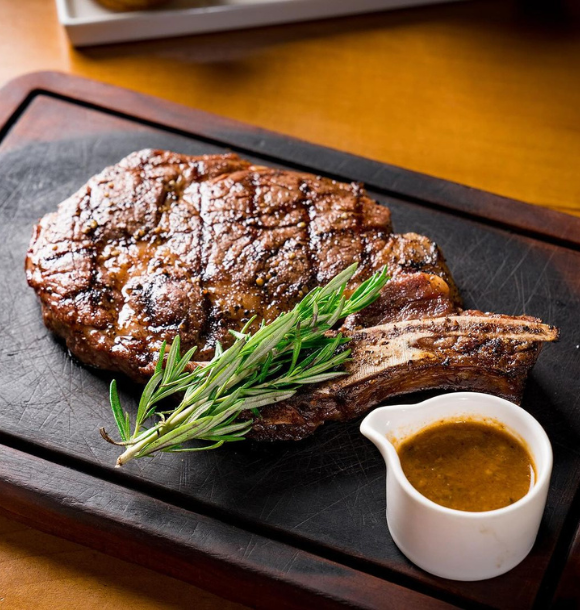
Photo Credits @porterhouse_ksa
The Porterhouse steak is a popular cut that combines two beef cuts. It is known for its large size and tenderness, making it a favorite for steak lovers. Here are the characteristics of the Porterhouse cut:
Porterhouse Steak:
- Flavor: Rich and Bold
- Tenderness: Very Tender
- Fat Content: Moderate
- Cooking Method: Best for grilling or broiling
The Porterhouse steak offers a rich and bold flavor due to the tenderloin and strip loin muscles. The moderate fat content adds flavor and juiciness, while protecting against overcooking.
For cooking, the best methods are grilling or broiling. These high-heat techniques sear the exterior, locking in the juices for a tender and flavorful steak.
Whether hosting a barbecue or enjoying a steak dinner, the Porterhouse is a versatile choice. Its combination of tenderness, flavor, and moderate fat content make it a delicious option for any occasion. So fire up the grill and savor the mouthwatering goodness of a perfectly cooked Porterhouse steak.
Flank

Photo Credits @giantchicago
Flank steak is a versatile and flavorful option for grilling. Here are some key points to consider:
- Tenderness: Flank steak is known for its tenderness, especially when cooked and sliced properly. It has a loose texture that allows marinades and seasonings to penetrate the meat.
- Flavor: Flank steak has a rich and beefy flavor. Its long, lean fibers make it perfect for marinating and absorbing flavors. It is also commonly used in dishes like fajitas and stir-fries.
- Cooking method: Flank steak is best when cooked quickly over high heat, such as on a hot grill or under a broiler. Cook it to medium-rare or medium to maintain its tenderness.
- Serving: To maximize tenderness, slice flank steak thinly against the grain. This ensures that the meat is not tough or chewy.
- Marinade: Marinating flank steak before grilling enhances its flavor. A mixture of soy sauce, garlic, ginger, and lime juice can add a delicious tang to the meat.
By considering tenderness, flavor, cooking method, serving technique, and the option of marinating, you can make the most out of flank steak for your next grilling endeavor. Its versatility makes it suitable for a wide range of dishes, allowing you to experiment and create flavorful meals.
How to Choose the Best Steak Cut for Your Grill

Photo Credits: Www.Moderngentlemanmagazine.Com by Mark Jackson
Choosing the Best Steak Cut for Your Grill
When it comes to grilling the perfect steak, selecting the right cut is crucial. There are several factors you should consider in order to make the best choice:
– Tenderness: The tenderness of steak cuts can vary. For grilling, it is ideal to choose tender cuts such as filet mignon or ribeye, as they are juicy and tender.
– Flavor: Each steak cut has its own unique flavor profile. If you prefer a rich and buttery taste, opt for a ribeye or New York strip. On the other hand, if you desire a stronger and beefier flavor, consider a T-bone or porterhouse.
– Thickness: The thickness of the steak impacts cooking time and juiciness. Thicker cuts are best for grilling as they develop a charred crust while retaining a juicy and medium-rare center.
– Fat Content: The distribution of fat or marbling in the steak greatly contributes to its tenderness and flavor. Steaks with more marbling, such as ribeye or sirloin, will offer a succulent and flavorful experience when grilled.
– Cooking Method: Take into account the cooking method you plan to use for your steak. Thicker cuts like ribeye or porterhouse are perfect for grilling over direct heat, while thinner cuts like skirt or flank steak are suitable for high-heat methods like stir-frying or broiling.
– Budget: Different steak cuts come at varying price points. Consider your budget and choose a cut that provides the desired balance of taste and affordability.
By carefully considering these factors, you can confidently select the best steak cut for your grill and ensure a truly enjoyable dining experience.
Tips for Cooking Steaks on the Grill
Get ready to master the art of grilling the perfect steak! In this section, we’ll uncover some vital tips and tricks for cooking mouthwatering steaks on the grill. From preparing your steaks to achieving the right grill temperature, seasoning and marinating techniques, cooking methods, ideal cooking times, and finishing with a perfect serving, we’ve got you covered. Get ready to elevate your grilling skills and become a steak connoisseur. Let’s fire up those grills and unleash the sizzling goodness!
Prepare steaks
When preparing steaks for the grill, it’s important to follow these steps to achieve the best results. To start, make sure you select high-quality steaks that are well-marbled and have good fat content. This will enhance the flavor and tenderness of the meat.
Next, take the steaks out of the refrigerator and allow them to sit at room temperature for approximately 30 minutes. This will help ensure that they cook evenly on the grill.
Before grilling, season the steaks with salt, pepper, or any desired seasonings. Make sure to rub the seasonings into the meat so that they adhere properly.
To prepare the grill, preheat it to medium-high heat. It’s also important to clean the grill grates and lightly oil them to prevent the steaks from sticking.
Once the grill is ready, place the steaks on the hot grill and close the lid. Cook them for around 4-6 minutes per side for a medium-rare doneness. Adjust the cooking time according to your preference.
While grilling, avoid pressing down on the steaks with a spatula. This can cause the juices to escape, resulting in a drier steak.
After cooking the steaks to your liking, remove them from the grill and let them rest for a few minutes. This will allow the juices to redistribute, resulting in a more tender and flavorful steak.
Serve the steaks hot and savor the delicious flavors.
By following these steps, you can expertly prepare steaks that are flavorful, tender, and perfectly cooked on the grill.
Grill temperature and heat
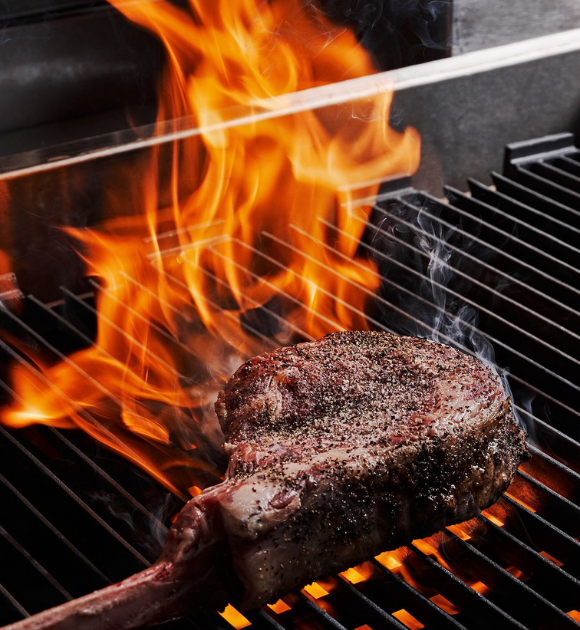
Photo Credits @marcuscooks
To cook a perfect steak, it is essential to have a good understanding of grill temperature and heat. The temperature of your grill plays a significant role in affecting the tenderness and flavor of your steak.
Different levels of grill temperature have various effects on steak:
– High Heat (450°F – 550°F): This level of heat helps seal in the juices and creates a delicious crust on the outside of the steak.
– Medium Heat (350°F – 450°F): This moderate level of heat allows the steak to cook evenly without charring the exterior.
– Low Heat (250°F – 350°F): This lower level of heat is perfect for slow cooking thicker cuts of steak, resulting in a tender and juicy texture.
Prior to placing your steak on the grates, it is important to preheat your grill to the desired temperature. This ensures that your steak cooks evenly and prevents it from sticking. Throughout the cooking process, it is crucial to maintain a consistent grill temperature to achieve your desired level of doneness.
In order to control the heat on a charcoal grill, you can adjust the airflow by opening or closing the vents. On a gas grill, you can adjust the burners to achieve your desired temperature.
It is worth noting that the thickness of your steak will influence the cooking time. Thicker steaks require lower heat or indirect grilling in order to cook evenly without burning the outside.
Understanding and effectively controlling grill temperature and heat are essential components of grilling the perfect steak. It is recommended to experiment with different temperatures to find your preferred cooking method, and always monitor the grill closely for desired results.
Seasoning and marinating
Seasoning and marinating are crucial for enhancing the flavor and tenderness of grilled steaks. Here are some key points to consider:
1. Choose the right seasoning: Use a blend of salt, pepper, garlic powder, and herbs that complements the natural flavors of the steak. This will bring out the richness of the meat and add depth to the taste.
2. Apply the seasoning generously: Coat both sides of the steak generously with the seasoning to ensure the flavors penetrate the meat. This creates a delicious crust and enhances every bite.
3. Marinate for added flavor: Use a marinade with acidic liquids (like lemon juice or vinegar), oil, herbs, and spices to further enhance the taste and tenderness of the steak. For best results, marinate for 30 minutes to several hours, depending on the thickness of the cut.
4. Let the steak rest: After seasoning and marinating, let the steak rest at room temperature for 15-30 minutes. This allows the flavors to permeate the meat and ensures even cooking.
5. Consider the cooking method: Adjust the seasoning and marinating process based on the cooking method. For grilling, pat the steak dry before placing it on the grill to ensure a good sear, lock in the juices, and develop a flavorful crust.
By following these tips, you can elevate the taste of your grilled steak and create a mouthwatering masterpiece. Enjoy the delicious flavors that seasoning and marinating bring to your meal!
Cooking techniques
Cooking techniques are crucial for preparing a delicious steak on the grill. Here are key techniques to keep in mind:
1. Preparing steaks: Season steaks with salt and pepper before grilling. Let them sit at room temperature for 30 minutes for even cooking.
2. Grill temperature and heat: Preheat the grill to medium-high heat for proper searing and caramelization.
3. Seasoning and marinating: Use a marinade or seasoning to enhance the steak’s flavor. Marinate for at least 30 minutes or overnight for better flavor absorption.
4. Choose different techniques based on desired doneness. For rare steaks, sear quickly on high heat, then move to indirect heat. For medium or well-done steaks, use indirect heat for longer cooking.
5. Cooking time and doneness: Monitor the internal temperature using a meat thermometer. Medium-rare steak should reach 135°F (57°C), medium steak at 145°F (63°C), and well-done steak at 160°F (71°C).
6. Resting and serving: Allow the steaks to rest after grilling to redistribute juices for a juicier and more flavorful steak.
By employing these techniques, you can ensure a perfectly cooked and flavorful steak. Experiment with different techniques and seasonings to find your preferred grill preparation method.
Cooking time and doneness
Cooking time and doneness are important when grilling steaks. The table below provides cooking times and desired doneness for different steak cuts.
| Steak Cut | Cooking Time | Desired Doneness |
| Ribeye | 4-6 minutes per side | Medium-rare to medium |
| New York Strip | 4-5 minutes per side | Medium-rare to medium |
| Filet Mignon | 3-4 minutes per side | Medium-rare to medium |
| T-Bone | 5-6 minutes per side | Medium-rare to medium |
| Sirloin | 4-5 minutes per side | Medium-rare to medium |
| Porterhouse | 5-6 minutes per side | Medium-rare to medium |
| Flank | 4-5 minutes per side | Medium to medium-well |
Please note that cooking times may vary based on steak thickness and desired doneness. Adjust accordingly. It is recommended to use a meat thermometer to ensure the steak reaches the desired internal temperature. For medium-rare, the internal temperature should be around 130-135°F (54-57°C), for medium around 140-145°F (60-63°C), and for medium-well around 150-155°F (66-68°C).
Experienced practice is necessary to achieve perfect doneness. Grill temperature, steak thickness, and personal preference also play a role. Allow the steak to rest for a few minutes before serving to allow the juices to redistribute. Enjoy your perfectly cooked steak!
Resting and serving
Resting and serving are crucial steps for achieving the best results when cooking and serving steaks. Follow these key steps:
1. Remove the steak from the grill: Carefully take the steak off the grill using tongs or a spatula. Place it on a clean plate or cutting board.
2. Let it rest: Allow the steak to rest for a few minutes before serving. This allows the juices inside the steak to redistribute, resulting in a juicier and more flavorful outcome. Let the steak rest for about 5 minutes for every inch of thickness.
3. Tent with foil: To keep the steak warm while it rests, cover it loosely with aluminum foil. This helps retain the heat and prevent the steak from overcooking or getting cold.
4. Slice and serve: After the resting period, it’s time to slice and serve the steak. Use a sharp knife to cut the steak into thin slices against the grain, which enhances tenderness. Serve the slices on individual plates or a platter, depending on your preference.
5. Garnish and enjoy: Add herbs, sauces, or a squeeze of lemon juice to the steak slices for extra flavor. Pair it with your favorite sides like vegetables, potatoes, or a fresh salad. Sit back and enjoy your perfectly rested and served steak.
By following these steps for resting and serving your steak, you’ll ensure a delicious dining experience. Remember, this is just one part of the process. Be sure to check out the complete article for more information on choosing and cooking the best steak cuts for your grill.
Frequently Asked Questions
What are the best cuts of steak for grilling?
The best cuts of steak for grilling include ribeye, NY strip, porterhouse/T-bone, and top sirloin. These cuts are known for their tenderness and flavor when cooked on the grill.
How do I prepare a steak for grilling?
To prepare a steak for grilling, pat it dry and season it with salt and pepper. You can also marinate the steak to add more flavor. Let the steak come to room temperature before cooking.
How long should I grill a steak for?
The grilling time for a steak depends on the thickness and desired level of doneness. For a 1-inch steak, grill it for approximately 3-4 minutes per side over direct, high heat. For a 2-inch steak, grill it for the same amount of time per side over direct, high heat, then move it to indirect heat until it reaches the desired internal temperature.
How can I make a steak juicy and tender?
To make a steak juicy and tender, you can marinate or season it, pierce it with a fork, sear it on both sides, avoid overcooking, and let it rest before slicing and serving.
What are the characteristics of a perfect steak?
A perfect steak has a nice deep brown crust, juicy tender meat inside, and a rosy pink color from crust to crust. It is cooked evenly and has optimal flavor and tenderness.
What are the recommended cuts of meat for grilling?
The recommended cuts of meat for grilling include Filet Mignon, New York Strip, and ribeye. These cuts are known for their tenderness and flavor when cooked on the grill.
